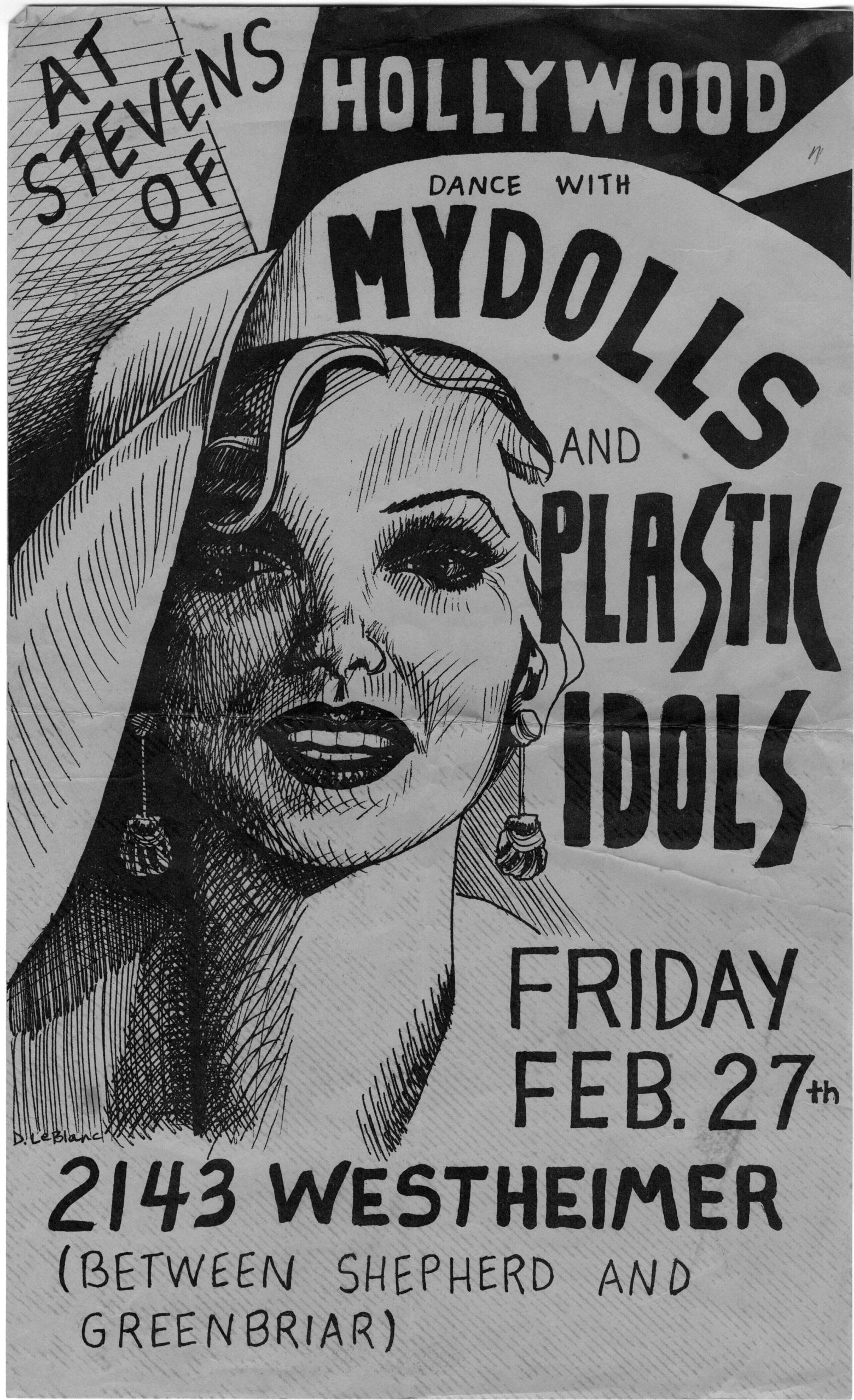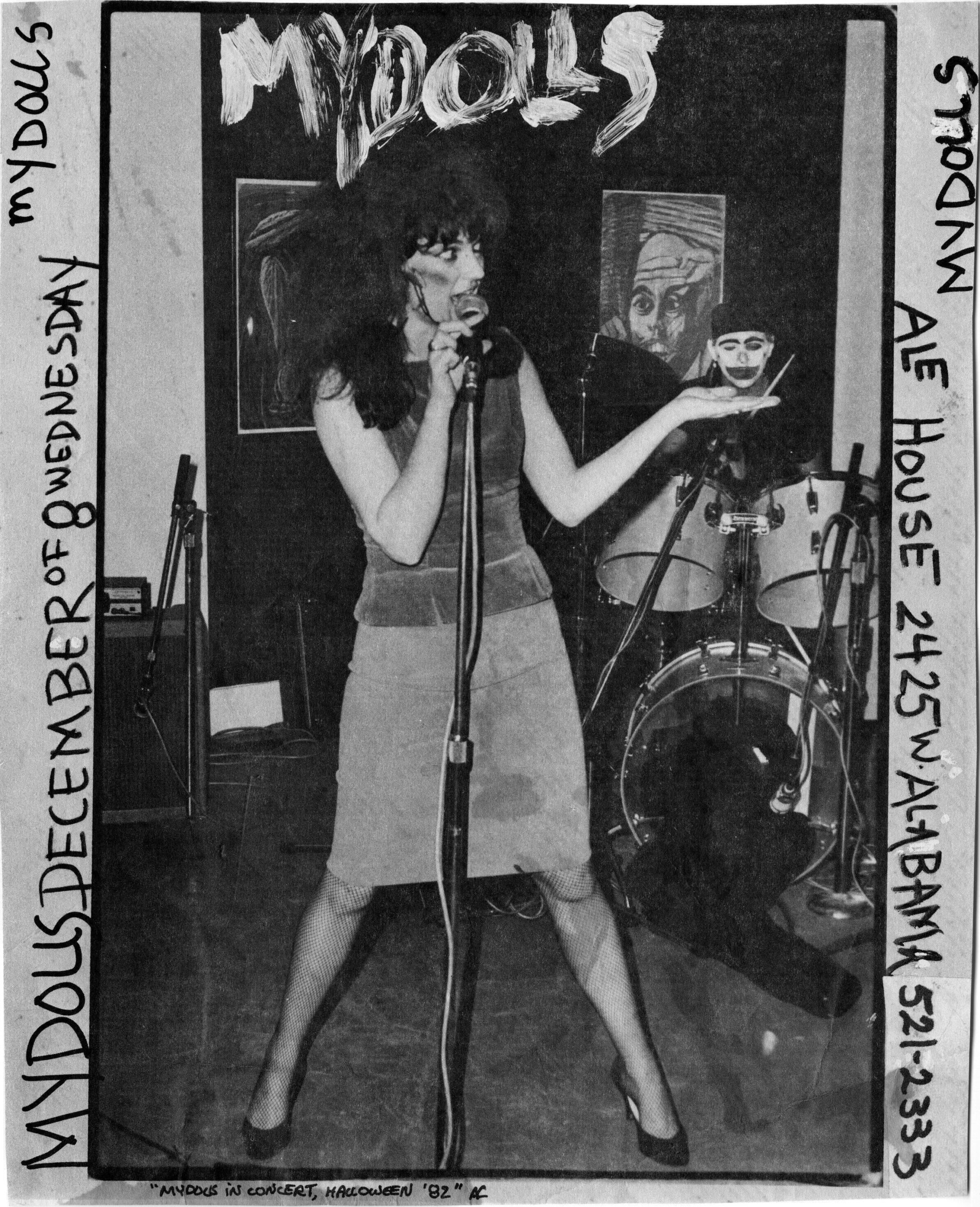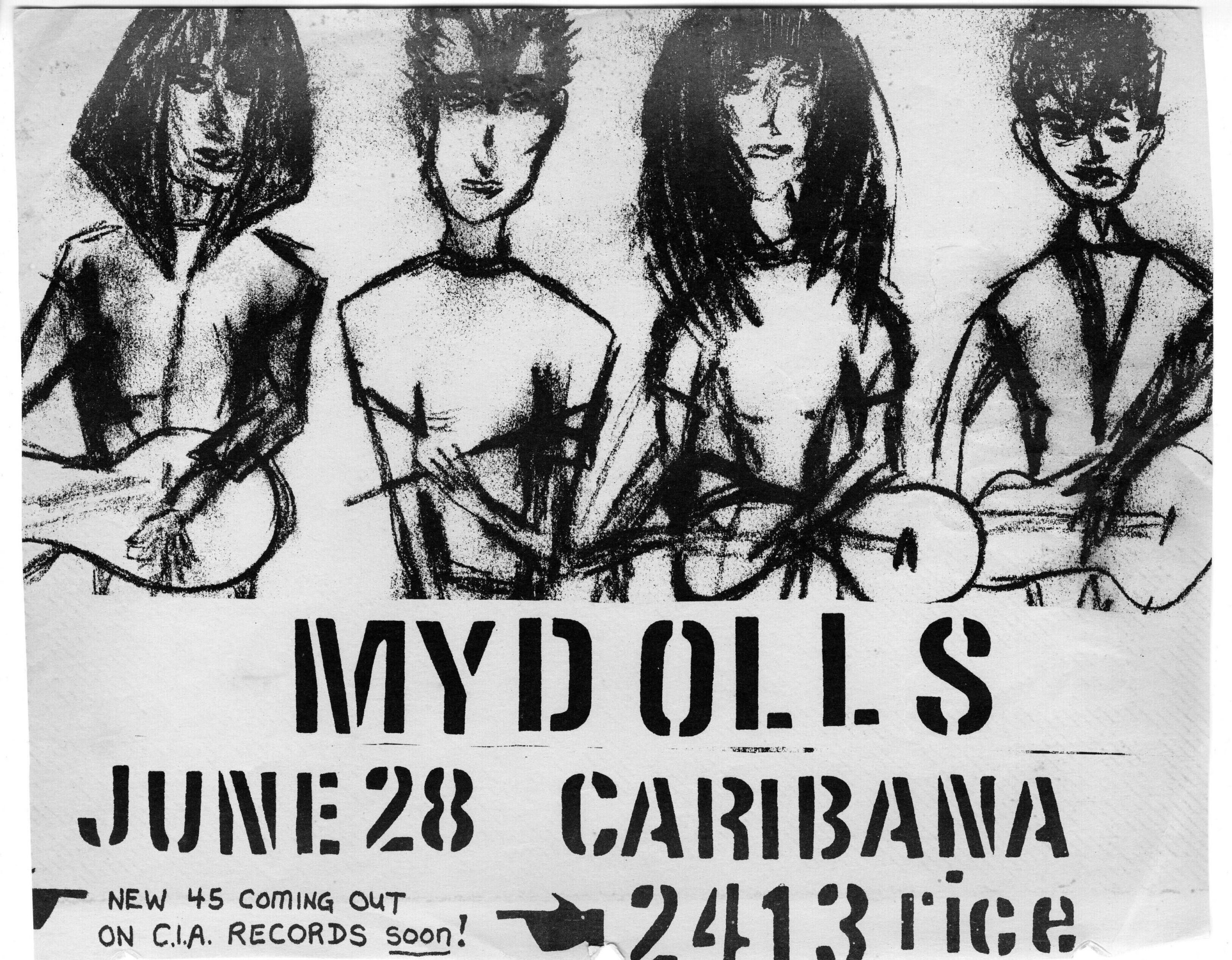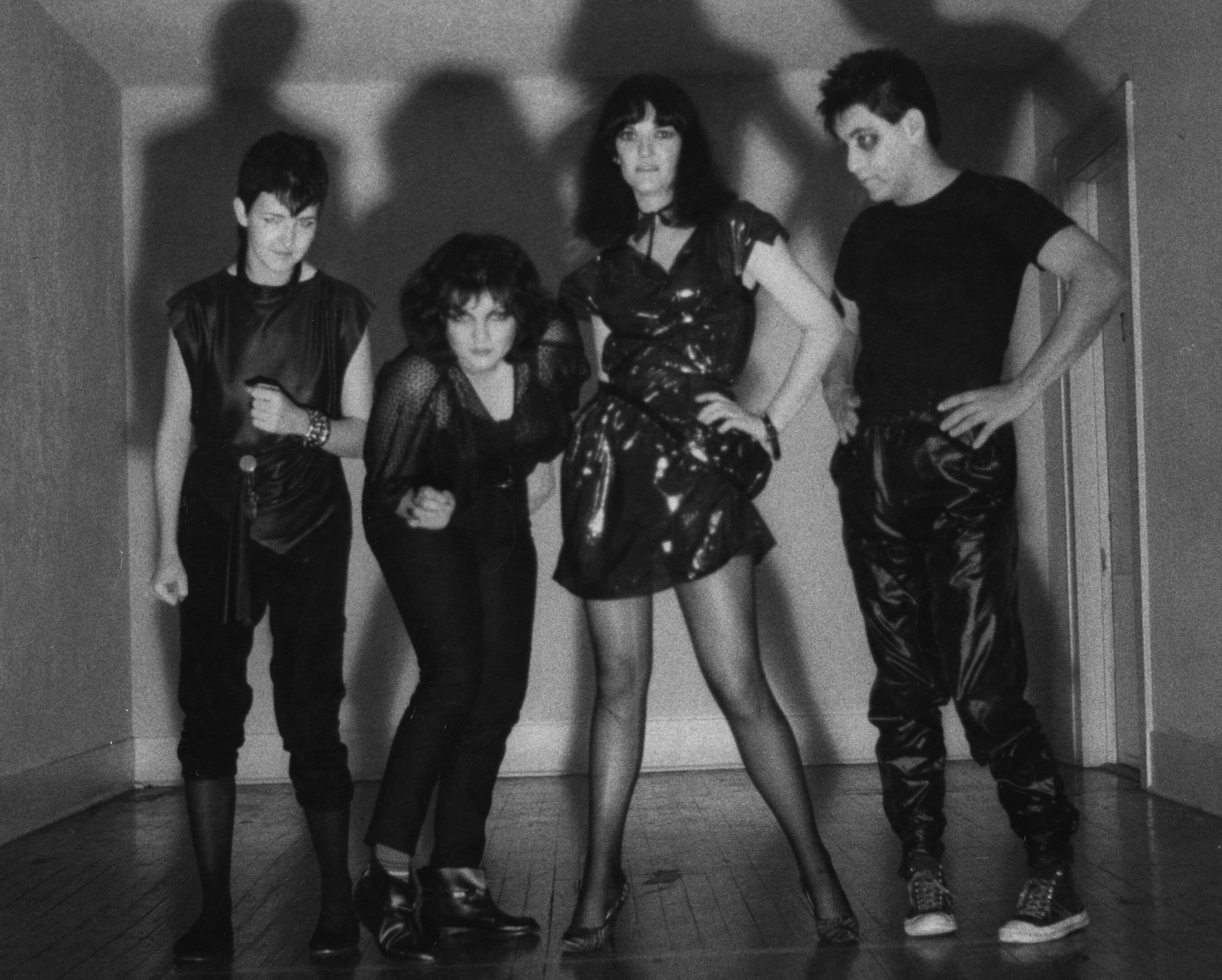
Jenna Guinn, practicum student from the University of North Texas, shares research and resources related to her work with the Mydolls Records at the University of Houston Special Collections.
Mydolls exploded onto the Houston punk scene in the late 1970s and have been influencing pop rock ever since. Known for their mainly self taught, eclectic style, they used their influence to help pave the way for other women and minorities to break into the genre. Not known for being quiet, their lyrics often commented on the systematic problems prevalent at the time. Formed in 1978, the group consisted of Linda Younger on guitar and vocals, Dianna Ray on bass and vocals, Trish Herrera on guitar and vocals, and George Reyes on drums and vocals, and was active until 1986. The group reunited in 2008, and has been intermittently touring, creating music, and influencing the next generation of young alternative punk rockers ever since. In 2016 the Contemporary Arts Museum of Houston highlighted Mydolls as a part of their 20Hertz music lecture series. The series described Mydolls “as one of the earliest art punk bands in Houston, Mydolls created a DIY sound that was as ethereal, fluid and poetic as it was politically charged and feminist. Throughout their nearly 40-year history, these pioneering musicians have paved a path for women and minorities in the music and arts scenes, and they continue to perform today with their original lineup.” The band released three recordings on Houston’s C.I.A. Records during the 1980s. Mydolls songs were included on compilations: Cottage Cheese from the Lips of Death (Ward-9 Records, 1983), Sub Pop 7 (Sub Pop Records, 1983), and The Dog That Wouldn’t Die (C.I.A., 1986). The album, A World of Her Own, was released by Grand Theft Auto in 2005. In 2015 Mydolls eight-song CD It’s Too Hot for Revolution was released. The band also appeared in a cameo in the award winning film Paris, Texas with their song “A World of Her Own.” 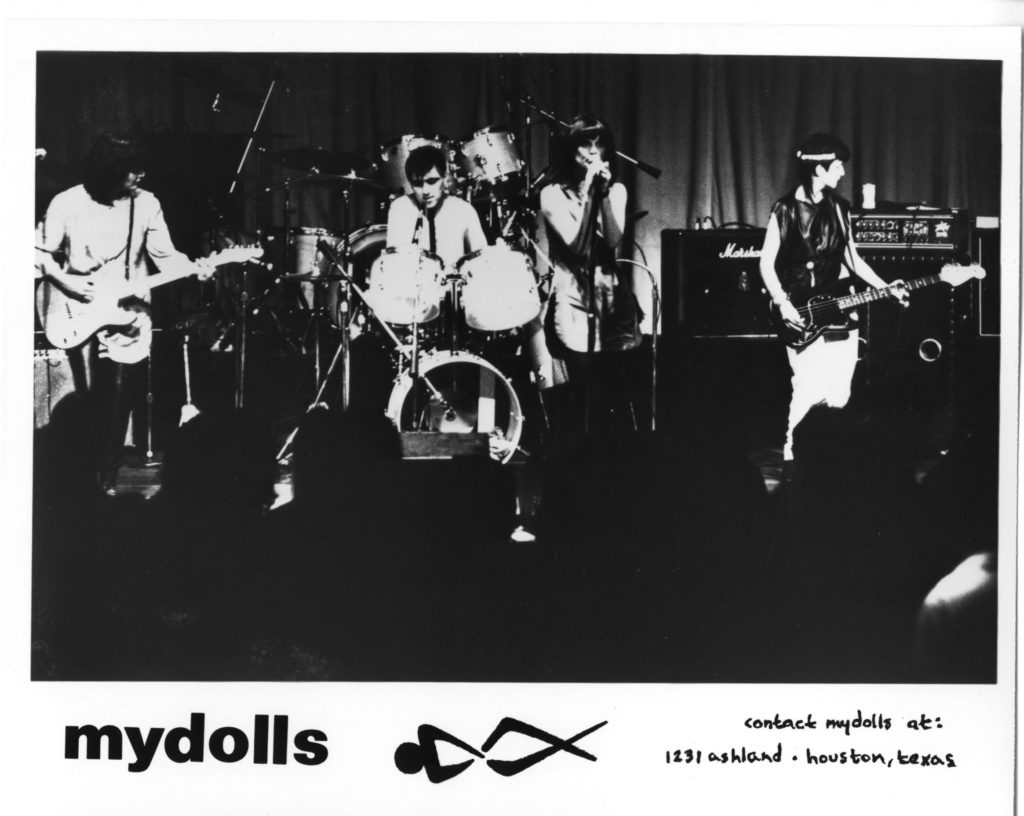
In 2019, Mydolls donated their discography, video performances, photographs, zines and more to the University of Houston Special Collections Department. Many items in the Mydolls Records come straight out of the underground punk rock scene of the 80s. Mydolls’ discography is preserved in vinyl records and various filmed performances are housed in the collection. The collection showcases the fast-paced career of Mydolls memorialized in zines, photographs, and performance ads and can be viewed at the Special Collections Department upon request.
Alexander Rodriguez, undergraduate student from the University of Chicago, takes a look at records from a reality TV show filmed at the University of Houston.
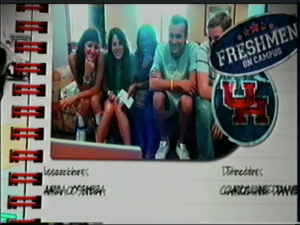
Still from Freshmen On Campus end credits, showing the five students and series iconography (UH Marketing and Communications, University of Houston Special Collections)
During the 2005 spring term, amongst our Cougar ranks walked five TV stars- well, reality TV stars, at least. As part of an acquisition from the University of Houston’s Division of Marketing and Communications, Special Collections has obtained archival materials relating to a reality TV show called Freshmen On Campus. Filmed by Princess Productions in 2005, the program follows five British students as they study at the University of Houston for a few weeks. Aside from the requisite teen drama, the show provides glimpses of American university life for viewers back in Britain, such as a fraternity pledge ceremony. The stars also check out things to do near Houston, visiting Galveston Beach and the Texas Prison Museum, excursions a UH student could reasonably make. Through participation in the show, these five get a taste of the University of Houston and experience college life in America. The university has tapes for Episodes 11 through 15 in the collection.
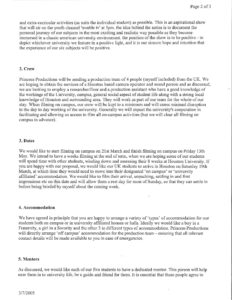
From a producer’s email, detailing the planning for the show (UH Marketing and Communications, University of Houston Special Collections)
However, equally exciting are the paper records that accompany the series in the archives. Consisting mostly of correspondence between the production company and the UH administration, these records depict all the planning and permissions needed to make the program happen. The documents include a wealth of information related to the logistics of filming a television series, from crew housing to food costs- even including the parking tickets issued to some of the filming crew for overrunning their parking meters. Reading through emails to UH staff, a sales pitch emerges: producers suggest that the show will put the University of Houston into the awareness of British teens and convince those looking to study in America to choose Houston. (Apparently, it also used to be normal for academic professionals to email each other in all lowercase.)
Viewing the finished episodes alongside the artifacts of its production provides a deeper understanding of the show and the medium in general. By seeing the presented product as well as the private effort that came before, archival research allows us to get past the surface and build a picture of what the experience was like for everyone involved. Reality TV is infamous for the ways it hides the real means of its creation, and in the early 2000s, the format was still unironically claiming to document real life. Now, in an era where we think more critically about reality TV shows and their real-world effects on people, it is fascinating to look back in time and get a peek behind the scenes of one such show that took the format away from Beverly Hills to a place more of us are familiar with.
The videotapes of the episodes, as well as the paper documents, are both in the UH Marketing and Communication Records at Special Collections.
Alexander Rodriguez, undergraduate student from the University of Chicago, takes a look at Professor Paul Chu’s presence in university marketing initiatives.
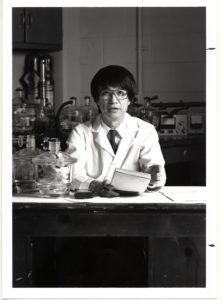
Paul Chu sitting at a lab desk (UH Photographs Collection, University of Houston Special Collections)
University of Houston (UH) Professor Paul Chu is a known name both on- and off-campus. In 1987, Chu and his team made breakthroughs in the field of superconductivity, developing materials that could conduct electricity with zero resistance at temperatures reachable with liquid nitrogen. This discovery kicked off a wave of excitement in the scientific community and put the university’s Department of Physics at the leading edge of this research.
In the late 1990s, UH’s Division of Marketing and Communications commissioned the production of 30-second television commercials for prospective students, starring university faculty with their work. One of these focuses on Chu, with shots of him with lab equipment demonstrating the materials developed in his lab. With floating magnets and nitrogen plumes aplenty, the clip is an effective counterargument to any high schooler who says physics can’t be cool.
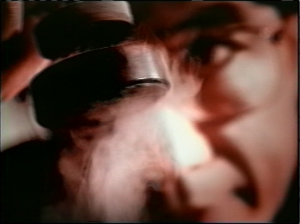
Still from UH commercial featuring Professor Chu (UH Marketing and Communications Records, University of Houston Special Collections)
Elsewhere, Chu and his research team garner mention from voices outside the university. In a compilation of news clips from November 2001, several television and radio stations reported on Dr. Chu’s move to Hong Kong to lead a research department there. True to the era, the reporters excitedly mention that he will continue to lead his UH research department through a technology known as “e-mail.” The similarity of the reporting across different channels indicates the use of a standardized press release, likely crafted by UH Marketing and Communications, to package the facts for news stations to add directly into their report.
These items, part of a Special Collections acquisition of UH Marketing and Communications Records this year, demonstrate the way the university showcases its faculty and their research as an asset for its image. The message for the public is that the work done here is not only research worth continuing but also the knowledge that has an impact on the lives of people outside academia and merits sharing. These outreach efforts establish the University of Houston as an institution on the forefront of science, attracting the next generation of bright minds to enroll and be a part of the spirit of innovation at the university.
Check out the full Marketing and Communications collection in the archival catalog here. More information about Chu and his research can be found elsewhere in Special Collections, including newspaper clippings in the Faculty Vita Records.
Jenna Guinn, practicum student from the University of North Texas, shares research and resources related to history of Shasta, the cougar mascot for the University of Houston.
If you attend a UH football game, you will most definitely see the university’s costumed mascot, Shasta the Cougar, doing push ups on the sidelines with each new point scored. However, it wasn’t too long ago that spectators would see a live cougar prowling the sidelines accompanied by her Cougar Guard. Between 1947 and 1989, five live female cougars held the position of the University of Houston’s mascot.
The choice of a cougar as the university’s mascot can be attributed to John R. Bender, who arrived at the university in 1927 as a volunteer football coach. Bender, the former head coach for the Washington State Cougars, held the animal in high regard and suggested naming the university’s new football team after the animal. The student newspaper and student organizations quickly adopted the name. In 1946, the cougar was named the official mascot of the University of Houston.

The Cougar Guard poses with Shasta I for a yearbook photo. (Houstonian)
In 1947, the Alpha Phi Omega fraternity purchased a cougar from a wildlife preserve under the condition that students at the university could crowdfund for the cougar’s cage and habitat. Articles about the crowdfunding efforts and excitement for the cougar’s arrival abound in the university’s newspaper, The Cougar, from the time period. The students were able to raise enough money, and sure enough, the cougar arrived by plane on October 17, 1947 just in time to attend her first football game the next day. A contest to choose a name for the new mascot was underway shortly after her arrival. Among 225 entries, student Joe Randol won the contest with the following submission: “Shasta (She has to). Shasta have a cage, Shasta have a keeper, Shasta have a winning ball club, Shasta have the best.” Alpha Phi Omega created the Cougar Guard, a select group of members that were responsible for Shasta’s care.
Shasta Ⅰ was not only the university’s first mascot. Serving from 1947-1962 she also held the post for the longest of all the cougars. Shasta Ⅰ lived at the Hermann Park Zoo and attended sporting events chaperoned by the Cougar Guard. In 1953, she was involved in an accident and lost one of her front toes on the way to a game. Tradition says that the opposing team, the University of Texas, mocked UH by imitating the injury. The Cougars, however, adopted the gesture as a symbol of pride and now at game time, Cougar fans show their support by making the “cougar sign,” folding the ring finger of the right hand toward the palm. Shasta Ⅰ also had three cubs: Tom Jr, Shorty, and Hasta, all of whom made an appearances in the pages of the Houstonian from time to time. Shasta Ⅰ retired in 1962.
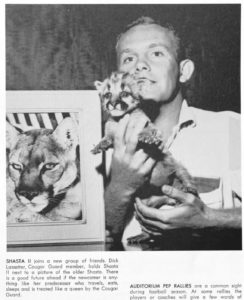
The debut of Shasta II next to a photo of her predecessor. (Houstonian)
Shasta Ⅱ was the university’s mascot from 1962-1965. She made her debut at just 5 weeks old at an October 1960 pep rally, and was in training until Shasta Ⅰ retired, at 14 years old. She had the shortest reign due to unruly, predictably cougar-like, behavior. A November 1964 article in The Cougar stated, “Although Shasta is bad-tempered, she is appreciated by the students. Besides, cougars are supposed to be mean. The students would like to see the meanness rub off on the UH football team.” She was the first cougar to reside on campus full time in Shasta’s Den, a small enclosure located in the southeast corner of Lynn Eusan Park. Shasta Ⅱ was retired to the Waco Zoo at 5 years old.
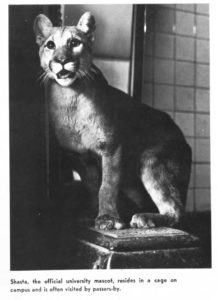
Shasta III, “The Lady,” rests in her on-campus enclosure. (Houstonian)
Shasta Ⅲ, a.k.a. “The Lady” served from 1965-1977, and may have been the most famous of all the university’s cougars. Along with being the university’s mascot, “The Lady” was featured in commercial spots for American Motors. Shasta Ⅲ made her mascot debut during the November 6, 1965 homecoming game. She became an official alumnus in 1977 and retired due to worsening arthritis. Shasta was pulled around the Astrodome in her wagon one last time during the UH Homecoming Game. An anonymous donation of $7,000 was made for a second enclosure for Shasta Ⅳ, so that Shasta Ⅲ could remain in her enclosure on campus. Shasta Ⅲ was one of the most beloved cougars that ever prowled university grounds, she even graces the 1975 cover of the Houstonian.
Shasta Ⅳ, a.k.a. “Baby Shasta” was promoted to university mascot when she was just 11 weeks old in 1977. However, when “Baby” grew up, the Cougar Guard could not control her, much like her predecessor Shasta Ⅱ. “Baby Shasta” retired in 1980 at the young age of three. Shasta Ⅳ did make a lasting impression on one of the Cougar Guard members charged with her care. Justin Leiber, an author, philosopher, and graduate of the University of Houston, was so impressed by Shasta Ⅳ that he made her a recurring character in two of his science fiction novels. An article in the 1989 Houstonian details their close relationship.
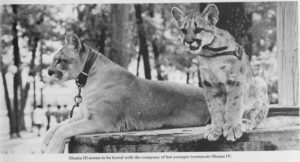
Shasta III and Shasta IV share reside together in their on-campus enclosure after an anonymous donation was made to expand the enclosure. (Houstonian)
Shasta Ⅴ made her debut on November 4, 1980. She held the position of beloved mascot for nine years when she was euthanized due to kidney failure in 1989. When Shasta Ⅴ’s reign came to an end there was much discussion over the ethics of housing a wild animal on campus and controversy amongst staff and students over the size of Shasta’s Den and her quality of life. There were even attempts to fundraise for a larger enclosure before Shasta Ⅴ’s passing. In 1989 Interim President George Magner ruled that the tradition of a live mascot would end with the death of Shasta Ⅴ, bringing a 42 year tradition to an end. The decision was made based on liability, funds, and animal exploitation/rights. However, the decision went against the majority opinion of the students at the time.
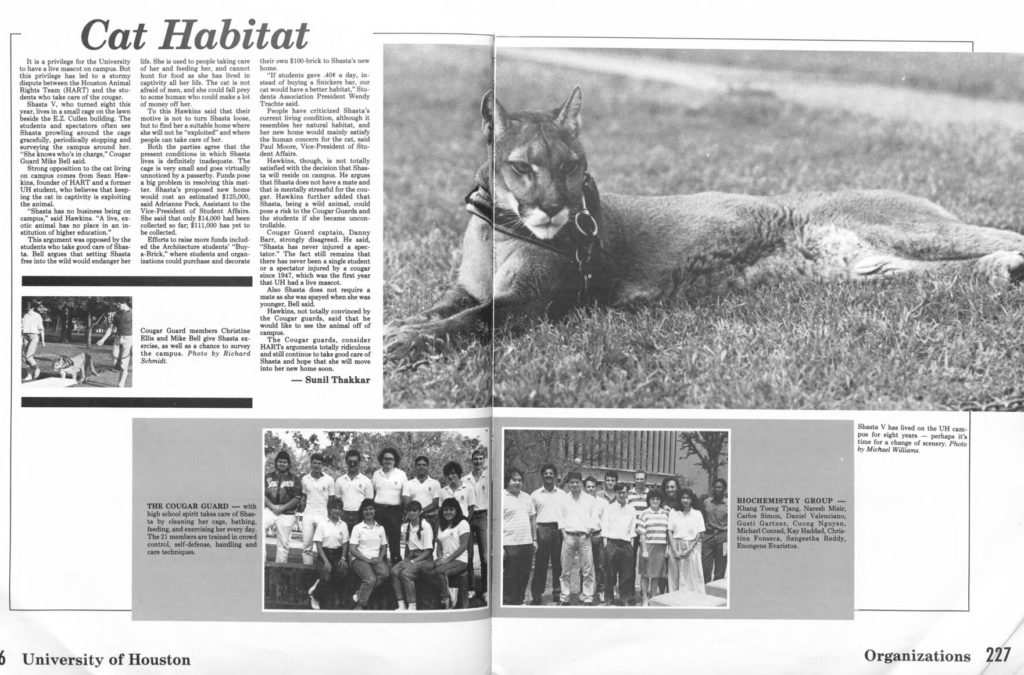
Shasta V appears in an article in the 1988 Houstonian debating the ethics of keeping a wild cougar on campus. (Houstonian)
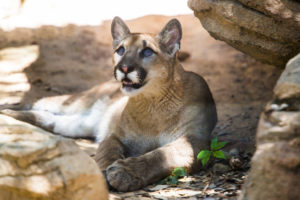
Shasta VI calls the Houston Zoo his home. (Houston Zoo)
It would be 22 years before UH was blessed with another iteration of Shasta. In 2011, the Houston Zoo rescued a cougar cub whose mother had been illegally killed in Washington State. How fitting that Shasta Ⅵ would come from the very place that inspired John R. Bender back in 1927. The zoo entered into a partnership with UH Alumni Association and on March 24, 2012 Shasta Ⅵ was introduced to the public and became an ambassador for the university. Shasta Ⅵ is the first live male cougar mascot. While Shasta Ⅵ resides exclusively at the Houston Zoo, he does attend important university events…via webcam. Before the biannual ring ceremonies, class rings spend the night in the cougar habitat to be blessed by Shasta. Students can visit Shasta Ⅵ at the zoo for free with a student ID.
The University of Houston’s Specially Collections Department has many resources that highlight Shasta Ⅰ-Ⅴ, including pictures and articles in archived versions of The Cougar and Houstonian.
Katy Allred, graduate student assistant from the University of North Texas Library Science program, provides us with insight into the lives of Dorothy Hood, José María Velasco Maidana, and Khory the Cat.
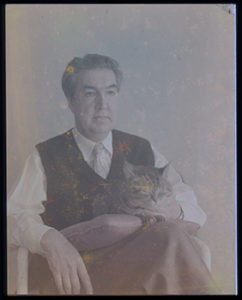
José María Velasco Maidana and Khory (José María Velasco Maidana Papers, University of Houston Special Collections)
Dorothy Hood and José María Velasco Maidana met in Mexico City in the 1940s and married in 1946. She was a young American painter and writer starting to make a name for herself, and he was a well-known Bolivian composer and conductor 20 years her senior. The two never had children together, but they did have an important family member early in their marriage who accompanied them on their many travels – a cat named Khory. Khory the cosmopolitan cat traveled by rail from Mexico to New York City, sat for a portrait with Velasco Maidana, and was even featured in a Houston Chronicle article by Ann Holmes, the newspaper’s fine arts editor who wrote: “The Maidanas are on their way to New York for a five-month stay, in company with their creole cat, name Khory, who travels-with no sense of disgrace at all-in a birdcage!”
Hood and Velasco Maidana traveled together often, but sometimes their work obligations took them in different directions. Velasco Maidana wrote several letters to Dorothy during these times apart in the late 1950s, in which he would sometimes update her on Khory’s activities, and he always signed off with salutations from both himself and Khory the cat – or sometimes just from Khory. In one letter, Velasco Maidana writes, “[Khory] received the kisses that you sent him and for his part today sends you many meows, which I hope sounds very sweet to your ears.”
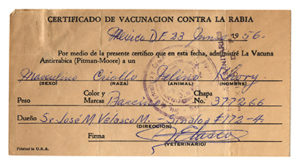
Rabies vaccination card for Khory the Cat (José María Velasco Maidana Papers, University of Houston Special Collections)
The story of Khory the cat is a small facet of the rich and varied materials in the Dorothy Hood Papers and the José María Velasco Maidana Papers, which are both now open for research. Hood’s materials include correspondence, scrapbooks, exhibition programs, writings, including manuscripts of her unpublished autobiography, photographs, publicity and press, and realia that paints a picture of a woman making her living as an artist in Houston in the last half of the 20th century. Velasco Maidana’s collection includes handwritten musical scores of his compositions, correspondence, scrapbooks, press, recordings of performances of his music, and a variety of materials related to the Amerindia ballet he composed, including the scores, paintings of costume designs, choreography notes, and correspondence. The University of Houston Special Collections is currently open by appointment; for more information, please contact Christian Kelleher at cdkelleher@uh.edu.
